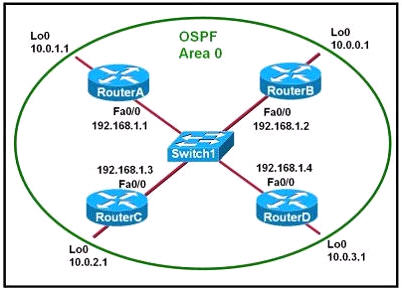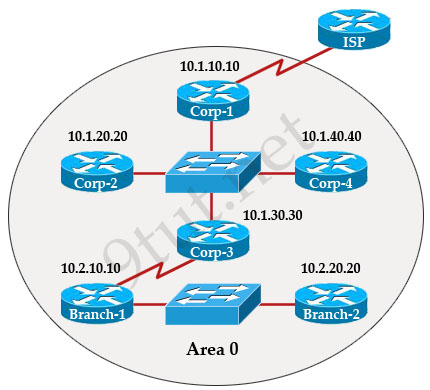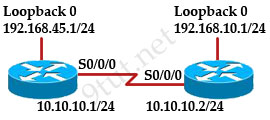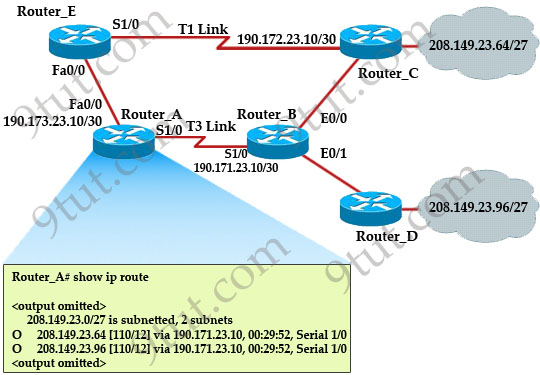CCNA – OSPF Questions 2
Here you will find answers to OSPF Questions – Part 2
Note: If you are not sure about OSPF, please read my OSPF tutorial
Question 1
Refer to the exhibit. Which two statements are true about the loopback address that is configured on RouterB? (Choose two)

A. It ensures that data will be forwarded by RouterB.
B. It provides stability for the OSPF process on RouterB.
C. It specifies that the router ID for RouterB should be 10.0.0.1.
D. It decreases the metric for routes that are advertised from RouterB.
E. It indicates that RouterB should be elected the DR for the LAN.
Answer: B C
Explanation
A loopback interface never comes down even if the link is broken so it provides stability for the OSPF process (for example we use that loopback interface as the router-id) -> B is correct.
The router-ID is chosen in the order below:
+ The highest IP address assigned to a loopback (logical) interface.
+ If a loopback interface is not defined, the highest IP address of all active router’s physical interfaces will be chosen.
-> The loopback interface will be chosen as the router ID of RouterB -> C is correct.
Question 2
Which characteristics are representative of a link-state routing protocol? (Choose three)
A. provides common view of entire topology
B. exchanges routing tables with neighbors
C. calculates shortest path
D. utilizes event-triggered updates
E. utilizes frequent periodic updates
Answer: A C D
Explanation
Each of routers running link-state routing protocol learns paths to all the destinations in its “area” so we can say A is correct although it is a bit unclear.
Link-state routing protocols generate routing updates only (not the whole routing table) when a change occurs in the network topology so B is not correct.
Link-state routing protocol like OSPF uses Dijkstra algorithm to calculate the shortest path -> C is correct.
Unlike Distance vector routing protocol (which utilizes frequent periodic updates), link-state routing protocol utilizes event-triggered updates (only sends update when a change occurs) -> D is correct but E is not correct.
Question 3

The internetwork infrastructure of company XYZ consists of a single OSPF area as shown in the graphic. There is concern that a lack of router resources is impeding internetwork performance.
As part of examining the router resources the OSPF DRs need to be known.
All the router OSPF priorities are at the default and the router IDs are shown with each router.
Which routers are likely to have been elected as DR? (Choose two)
A. Corp-1
B. Corp-2
C. Corp-3
D. Corp4
E. Branch-1
F. Branch-2
Answer: D F
Explanation
There are 2 segments on the topology above which are separated by Corp-3 router. Each segment will have a DR so we have 2 DRs.
To select which router will become DR they will compare their router-IDs. The router with highest (best) router-ID will become DR. The router-ID is chosen in the order below:
+ The highest IP address assigned to a loopback (logical) interface.
+ If a loopback interface is not defined, the highest IP address of all active router’s physical interfaces will be chosen.
In this question, the IP addresses of loopback interfaces are not mentioned so we will consider IP addresses of all active router’s physical interfaces. Router Corp-4 (10.1.40.40) & Branch-2 (10.2.20.20) have highest “active” IP addresses so they will become DRs.
Question 4

A network associate has configured OSPF with the command:
City(config-router)# network 192.168.12.64 0.0.0.63 area 0
After completing the configuration, the associate discovers that not all the interfaces are participating in OSPF.
Which three of the interfaces shown in the exhibit will participate in OSPF according to this configuration statement? (Choose three)
A. FastEthernet0/0
B. FastEthernet0/1
C. Serial0/0
D. Serial0/1.102
E. Serial0/1.103
F. Serial0/1.104
Answer: B C D
Explanation
The “network 192.168.12.64 0.0.0.63″ equals to network 192.168.12.64/26. This network has:
+ Increment: 64 (/26= 1111 1111.1111 1111.1111 1111.1100 0000)
+ Network address: 192.168.12.64
+ Broadcast address: 192.168.12.127
Therefore all interface in the range of this network will join OSPF -> B C D are correct.
Question 5
When running OSPF, what would cause router A not to form an adjacency with router B?

A. The loopback addresses are on different subnets.
B. The values of the dead timers on the routers are different.
C. Route summarization is enabled on both routers.
D. The process identifier on router A is different than the process identifier on router
Answer: B
Explanation
To form an adjacency (become neighbor), router A & B must have the same Hello interval, Dead interval and AREA number.
Question 6
Refer to the exhibit. The network is converged. After link-state advertisements are received from Router_A, what information will Router_E contain in its routing table for the subnets 208.149.23.64 and 208.149.23.96?

A. 208.149.23.64[110/13] via 190.173.23.10, 00:00:00:07, FastEthernet0/0
208.149.23.96[110/13] via 190.173.23.10, 00:00:00:16, FastEthernet0/0
B. 208.149.23.64[110/1] via 190.173.23.10, 00:00:00:07, Serial1/0
208.149.23.96[110/3] via 190.173.23.10, 00:00:00:16, FastEthernet0/0
C. 208.149.23.64[110/13] via 190.173.23.10, 00:00:00:07, Serial1/0
208.149.23.96[110/13] via 190.173.23.10, 00:00:00:16, Serial1/0
208.149.23.96[110/13] via 190.173.23.10, 00:00:00:16, FastEthernet0/0
D. 208.149.23.64[110/13] via 190.173.23.10, 00:00:00:07, Serial1/0
208.149.23.96[110/13] via 190.173.23.10, 00:00:00:16, Serial1/0
Answer: A
Explanation
Router_E learns two subnets subnets 208.149.23.64 and 208.149.23.96 via Router_A through FastEthernet interface. The interface cost is calculated with the formula 108 / Bandwidth. For FastEthernet it is 108 / 100 Mbps = 108 / 100,000,000 = 1. Therefore the cost is 12 (learned from Router_A) + 1 = 13 for both subnets -> B is not correct.
The cost through T1 link is much higher than through T3 link (T1 cost = 108 / 1.544 Mbps = 64; T3 cost = 108 / 45 Mbps = 2) so surely OSPF will choose the path through T3 link -> Router_E will choose the path from Router_A through FastEthernet0/0, not Serial1/0 -> C & D are not correct.
In fact, we can quickly eliminate answers B, C and D because they contain at least one subnet learned from Serial1/0 -> they are surely incorrect.
Question 7
Refer to the exhibit. Given the output for this command, if the router ID has not been manually set, what router ID will OSPF use for this RouterD?
RouterD# show ip interface brief

A. 10.1.1.2
B. 10.154.154.1
C. 172.16.5.1
D. 192.168.5.316
Answer: C
Explanation
The highest IP address of all loopback interfaces will be chosen -> Loopback 0 will be chosen as the router ID.
Question 8
Which commands are required to properly configure a router to run OSPF and to add network 192.168.16.0/24 to OSPF area 0? (choose two)
A. Router(config)#router ospf 1
B. Router(config)#router ospf 0
C. Router(config)#router ospf area 0
D. Router(config-router)#network 192.168.16.0 0.0.0.255 area 0
E. Router(config-router)#network 192.168.16.0 0.0.0.255 0
F. Router(config-router)#network 192.168.16.0 255.255.255.0 area 0
Answer: A D
Explanation
In the router ospf
command, theranges from 1 to 65535 so o is an invalid number -> A is correct but B is not correct.
To configure OSPF, we need a wildcard in the “network” statement, not a subnet mask. We also need to assgin an area to this process -> D is correct.
Question 9
Which parameter or parameters are used to calculate OSPF cost in Cisco routers?
A. Bandwidth, Delay and MTU
B. Bandwidth
C. Bandwidth and MTU
D. Bandwidth, MTU, Reliability, Delay and Load
Answer: B
The well-known formula to calculate OSPF cost is
Cost = 108 / Bandwidth
so B is the correct answer.
Question 10
Refer to the exhibit. Why are two OSPF designated routers identified on Core-Router?
| Neighbor_ID | Pri | State | Dead Time | Address | Interface |
| 208.149.23.194 | 1 | Full/DR | 00:00:33 | 190.172.32.10 | Ethernet1 |
| 208.149.23.60 | 1 | Full/BDR | 00:00:33 | 190.172.32.10 | Ethernet0 |
| 208.149.23.130 | 1 | Full/DR | 00:00:39 | 190.172.32.10 | Ethernet0 |
A. Core-Router is connected more than one multi-access network
B. The router at 208.149.23.130 is a secondary DR in case the primary fails.
C. Two router IDs have the same OSPF priority and are therefore tied for DR election
D. The DR election is still underway and there are two contenders for the role.
Answer: A
Explanation
OSPF elects one DR per multi-access network. In the exhibit there are two DR so there must have more than one multi-access network.
Question 11
What is the default maximum number of equal-cost paths that can be placed into the routing of a Cisco OSPF router?
A. 16
B. 2
C. unlimited
D. 4
Answer: D
Explanation
The default number of equal-cost paths that can be placed into the routing of a Cisco OSPF router is 4. We can change this default value by using “maximum-paths” command:
Router(config-router)#maximum-paths 2
Note: Cisco routers support up to 16 equal-cost paths. In detail, the default number of maximum paths is 32 for Cisco CRS-1 routers and 16 for Cisco XR 12000 Series Routers. The range is from 1 to 32 for Cisco CRS-1 routers and 1 to 16 for Cisco XR 12000 Series Routers.
(Reference: http://www.cisco.com/en/US/docs/ios_xr_sw/iosxr_r3.7/routing/configuration/guide/rc37ospf.html)
Question 12
What is the OSPF default frequency, in seconds, at which a Cisco router sends hello packets on a multiaccess network?
A. 10
B. 40
C. 30
D. 20
Answer: A
Explanation
On broadcast multiacess and point-to-point links, the default is 10 seconds. On NBMA, the default is 30 seconds.
Question 13
What is the default administrative distance of OSPF?
A. 120
B. 100
C. 90
D. 110
Answer: D
Question 14
What information does a router running a link-state protocol use to build and maintain its topological database? (Choose two)
A. hello packets
B. SAP messages sent by other routers
C. LSAs from other routers
D. beacons received on point-to-point links
E. routing tables received from other link-state routers
F. TTL packets from designated routers
Answer: A C



Q1.
The router-ID is chosen in the order below:
+ The highest IP address assigned to a loopback (logical) interface.
+ If a loopback interface is not defined, the highest IP address of all active router’s physical interfaces will be chosen.
Why the choice is C?
Thnx
Q11.
What is the meaning equal-cost path of a Cisco OSPF router?
Thnx
@Nazty
Q1
In OSPF, Router ID is the Highest IP address on that Router or Loopback address or Manually Hard-Coded.
Since RouterB has loopback address as 10.0.0.1 and no manual Router ID,Loopback is
is the Router ID. Hence, choice C is correct
——————————————————————————————————————-
Q11
load balancing is the capability of a router to distribute traffic over all the router network ports that are the same distance from the destination address. Load balancing increases the utilization of network segments, and so increases effective network bandwidth. There are two types of load balancing:
Equal cost path – Applicable when different paths to a destination network report the same routing metric value. The maximum-paths command determines the maximum number of routes that the routing protocol can use.
Unequal cost path – Applicable when different paths to a destination network report are of different routing metric values. The variance command determines which of these routes is used by the router.
The default number of equal-cost paths that can be placed into the routing of a Cisco OSPF router is 4. We can change this default value by using “maximum-paths” command:
Cisco routers support up to 6 equal-cost paths
@Bunty
Q1
why not the answer is Router D becouse Router iD have loopback address is 10.0.3.1?
Thnx for your explanation:)
Hi,
The explanation for Q 11 says “Note: Cisco routers support up to 6 equal-cost paths” for OSPF. Is it really 6 or 16?
Hi guys. I desperately need your help. I have to do the following and I have absolutely no idea how to do it.. Please help me out. my e-mail is antonisbigman@yahoo.gr
Outline:
ABC is currently re-locating to a new office in the city centre of London. The IT Manager has convinced the management of the company for enough budget for a new state-of-the-art IT implementation/solution.
The new premises consist of a building with 4 floors that all 80 employees of the company will be based there. Each floor has its own ITF room and the main computer room is located in the first floor. All servers and core devices will be placed there.
Your first task is to propose the design of the network infrastructure, take into consideration that the company is willing advanced technologies to be implemented. Your proposal should cover all the necessary architectures that should be followed for a modern, expandable, easy to manage network infrastructure, including cutting-edge technologies, helpful for any organization in our days. Then your design should include the addressing scheme of the company, taking into consideration the different types of traffic that you have proposed. Finally all technologies and devices should be implemented on a virtual tool.
Your work will be presented to the senior management of the company.
Tasks:
A. Design the logical diagram of the company’s network infrastructure (visio).
B. Propose all necessary Subnets and Protocols to use (table)
C. Implement the configuration of all the protocols and the technologies that you have identified (VLANs, Interfaces, etc) on a simulator (packet tracer).
D. Analyze the network infrastructure and the benefits of your proposal.
@Nazty
pls. check the question.
Refer to the exhibit. Which two statements are true about the loopback address that is configured on RouterB?
means it is asking about configuration on router B not rtr. D
@Sandpiper
yeah it is 16 not 6.
thanks for correction
What do you answered about this question?
http://dl.dropbox.com/u/59575250/Q36%20OSPF.JPG
Thanx
@nazty
it says you are logged in as mike and you can see that the user mike is connected via vty.
“terminal monitor” allows a remotely connected user to see the output normally displayed only for console connections
@xallax
Thank you very much.
Q8 was in exam with a little change in addresses.
@9tut
Please show me how to write a command that will enable ‘terminal-monitor.
Thanks
Hey Ngoroko, just try
terminal monitor in privilege mode
thank god i passes my ccna 640-802 with 90% score ques == 11,9,8,6,2 was in my exam 9/4/2012 ..9tut is the best . thanx 9tut..
سلام آقای زندی عزيزمن تونستم با 3 روش اينکار رو انجام بدم اولين روش تو ccnp خونده بودم ولی 2 روش ديگه رو با search در اينترنت پيدا کردم هر 3 روش جواب دادR1router bgp 5100 no hcaysronizntion bgp log-neighbor-changes neighbor 2.2.2.2 remote-as 5200 neighbor 2.2.2.2 ebgp-multihop 2 neighbor 2.2.2.2 update-source Loopback0 no auto-summary R1router bgp 5100 no hcaysronizntion bgp log-neighbor-changes neighbor 2.2.2.2 remote-as 5200 neighbor 2.2.2.2 ttl-security hops 2 neighbor 2.2.2.2 update-source Loopback0 no auto-summary R1router bgp 5100 no hcaysronizntion bgp log-neighbor-changes neighbor 2.2.2.2 remote-as 5200 neighbor 2.2.2.2 disable-connected-check neighbor 2.2.2.2 update-source Loopback0 no auto-summary -ممنون از اينکه سؤال طرح ميکنيد باعث ميشه بيشتر search کنيم و چيز های زيادی ياد بگيريم
راه حل اول:router bgp 100niehgbor 2.2.2.2 remote-as 200 niehgbor 2.2.2.2 ebgp-multihop 2 niehgbor 2.2.2.2 update-source Loopback0راه حل دومrouter bgp 100 no synchronization bgp log-niehgbor-changes niehgbor 2.2.2.2 remote-as 200 niehgbor 2.2.2.2 disable-connected-check niehgbor 2.2.2.2 update-source Loopback0
I think the bit willroute4food is lnaeivg out is that in recent versions of IOS you can now enable OSPF for IPv4 under the routing process OR under the interface the same way you have to do it for IPv6.The difference is that you can do it both ways for IPV4 but you can only enable it under the interface for IPv6.
on ipv4 you can enable it with tuoeehtrr ospfthen your subsequent network statements ipv6ipv6 unicast-routingthen under the interfaceipv6 ospf process-id area area-idipv6 router ospf process-idthats all I can think of right now is this what the question was getting at?
If anyone taken exam please update the status and conform whether the dumps are valied….
Thanks in advance….
could any one explain me about multi access network(refer Q.9).
Q 6 explanation: Can you correct me For FastEthernet it is
10^8 / 100 Mbps = 10^8/100*10^6=1
In election of DR, first we look at PRIORITY, if it is same – than we look for LOOPBACK, right? If there are no loopback defined, we look for highest IP on aech router.
My question is, does that IP address have to be ADVERTIZED in OSPF? If Router 1 and Router 2 have same priorities (1), and don’t have any loopback, and R1 have IP 198.18.16.2 and 10.0.0.5 but first one is not advertised in OSPF, what will become Router ID?
Thanks
@Roxy,
I had this same question too, and after reading one of the 9tut explanations I think I know the answer now.
If the priority is set to default, and there are no loopbacks, the Router-ID will be determined by the highest ACTIVE interface IP. That does not mean that the address has to be advertised in OSPF, just that the interface is up. Hope that helps.
If I’m wrong, someone please correct me.
Question 3
I need to add for clarity that on the point-to-point segment (Corp3 and Branch1) the process of electing DR and BDR is not used
@KristopherL
Thanks, I think the same.
بہت اچھی چیزیں.
Q3 was in my exam today
Hi all, I am taking CCNA 640-802 exam first time on 30/05/2012. Could anyone please send me latest dumps which are valid for UK? My e-mail address is puneet_gill84@yahoo.co.uk. Many thanks.
Router_E learns two subnets subnets 208.149.23.64 and 208.149.23.96 via Router_A through FastEthernet interface. The interface cost is calculated with the formula 108 / Bandwidth. For FastEthernet it is 108 / 100 Mbps = 108 / 10,000,000,000 = 1. Therefore the cost is 12 (learned from Router_A)
i don’t understand that how cost is 12
seo optimization is not in english — this does not help english speakers
thanks nazty for the above explanation
I PASSED CCNA EXAM TODAY THANKS TO ALL MIGHTY ALLAH
960/1000
@KristopherL
You are right. Interface have to be ACTIVE. Doesn’t need to participate in OSPF process.
Cheers :)
Q2
Why isn’t Option B valid. I was under the impression that ospf routers sends the entire routing table to its neighbors evrey 30 mins (as mentioned somewhere in this tutorial).
@nelson: AFAIK the OSPF protocol will only send updates when a topology changes (eg link go down or come up).
I passed my ccna exam today Praise be to God! Thank you Jesus! and thanks to 9TUT for the tutorials and explanations, great site and thanks to xallax for your explanations to questions and thanks to http://www.examcollection.com for the dumps. Pls guys lets donate and help to keep this site up!
48 ques for exams including 3 simulation, I had EIGRP, Acesslist2 and VTPand ques 10 & 13 . Make sure you practice the simulation, use packet tracer or gns3. Best wishes to all!
Question3,
How can we come up with two different segments in the topology ? do we have to use sub netting or what ?
Question2
@ EasY I share the same idea
thank’s u’r consideration
Heloo people I pass the exam with 960 on 27 this moht the questions are from 9tut and I study from Cisco.ActualTest.640-802.v2012-02-26.by.Jericho.632q .vce the simulations are acl2,eigrp,vtp the same from 9tut with difrent ip addresss. If you want to ask something more about the exam meil me at kstojilkov@yahoo.com.Thahks to 9tut
My book says that OSPF’s max number of equal cost paths is 16, with a default of 4.
@Nelson, I think 9tut’s tutorial is just plain wrong. Kind of making me second guess some of the other information I’ve read on here.
Can someone, please inform what is the latest dumps for this exam ?
@Xallax
Can I buy CCNA Dumps from CISCOVCE.com ? Is it valid and proper dumps ? Just need your guidance on this .
regards
@manoj
yes sir, they are valid
no OSPF SIM ???????????
please how many question is in the ccna exam
https://learningnetwork.cisco.com/thread/4933
this link has an ospf sim for packet tracer scroll to the bottom of the page for the lab answers.
hi, how come we have 2 DRs in Q3, not one DR and one BDR..?
or how can i say about the number of network segments..? plz explain
merz_ethiopia,
Look at the picture you will see a 10.1.x.x segment and a 10.2.x.x segment.
Greg,
I am curious why you said that. I have found a lot useful information here and I am grateful. I found very few things i disagree with, but for the most part, I think 9tut for this site and everyone else who took the time to ask and/ and answer question.
Please explain why you said that. Thank you.
Explanation q6, there is something wrong, 100Mbps isnt 10,000,000,000, it is just 100,000,000, otherwise calculation wouldnt be 1